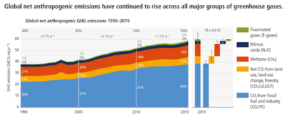In news– The Intergovernmental Panel on Climate Change(IPCC) has published the third part of the Sixth Assessment Report recently.
Key highlights of the third part-
- The report prepared by the IPCC Working Group III (WG-III) focuses on the mitigation of climate change, ie, the solutions necessary to halt global warming.
- It has found that greenhouse gas (GHG) emissions were 54 per cent higher in 2019 than they were in 1990, but growth is slowing.
- As per the re[prt, least developed countries emitted only 3.3 percent of global emissions in 2019.
- It says that pledges to the Paris Agreement are insufficient, emissions must fall 43 per cent by 2030 compared to 2019.

- Abundant and affordable solutions exist across sectors including energy, buildings, and transport, as well as individual behavioural changes.
- It says that the impact on GDP would be negligible and the long-term benefits of cutting emissions immediately would outweigh the initial costs.
- It says that unless the global greenhouse gas emissions peaks by 2025, just three years from now, and is cut by at least 43 per cent from current levels by 2030, the 1.5 degree target cannot be achieved.
- The likelihood of achieving the 1.5 degree target is now even lower than in 2018 when the IPCC had come out with a special report on the feasibility of keeping global rise in temperatures to within 1.5 degree Celsius.
- The climate actions that are currently promised would result in a world that would be about 3.2 degree Celsius warmer than pre-industrial times, and that is not a comfortable scenario at all.
- The situation already is so grim that, even after substantial reductions in emissions, human beings would have to rely on futuristic carbon dioxide removal (CDR) technologies to bring down the temperatures.
- CDR technologies, most of which are undeveloped and untested, refer to the physical removal of carbon dioxide from the atmosphere to reduce the greenhouse gas effect which leads to warming of the planet.
- Nearly half the world’s current emissions can be cut by 2030 using only technologies that cost less than US$100 to reduce one tonne of carbon dioxide equivalent.
- Examples of such technologies include large scale deployment of renewables like solar or wind energy, carbon sequestration in soil, reduction in deforestation and improvement of energy efficiency.
- And, 25 percent of the current emissions can be reduced using technologies that cost less than US$ 20 per tonne of CO2. Such technologies include the shift to electric vehicles, lifestyle changes like adoption of cycles instead of motorized vehicles, and large-scale use of public transport.
- Traditional sources of energy like oil, gas and coal would have to be almost completely abandoned over the next few decades if the climate goals have to be achieved.
- The IPCC report says that coal would need to be given up entirely by the year 2050, while the use of oil and gas need to be reduced by at least 60 and 70 per cent respectively.
The Intergovernmental Panel on Climate Change (IPCC)-
- It was established in 1988 to provide policymakers with regular scientific assessments on the current state of knowledge about climate change.
- The establishment of the IPCC was endorsed by the UN General Assembly in 1988.
- Its initial task, as outlined in UN General Assembly Resolution 43/53 of 6 December 1988, was to prepare a comprehensive review and recommendations with respect to the state of knowledge of the science of climate change; the social and economic impact of climate change, and potential response strategies and elements for inclusion in a possible future international convention on climate.
- Since 1988, the IPCC has had five assessment cycles and delivered five Assessment Reports in 1990, 1995, 2001, 2007 and 2015, the most comprehensive scientific reports about climate change produced worldwide. The recent one is the sixth.
- It has also produced a range of Methodology Reports, Special Reports and Technical Papers, in response to requests for information on specific scientific and technical matters from the United Nations Framework Convention on Climate Change (UNFCCC), governments and international organizations.
Further reading: https://journalsofindia.com/ipcc-sixth-assessment-report/
















